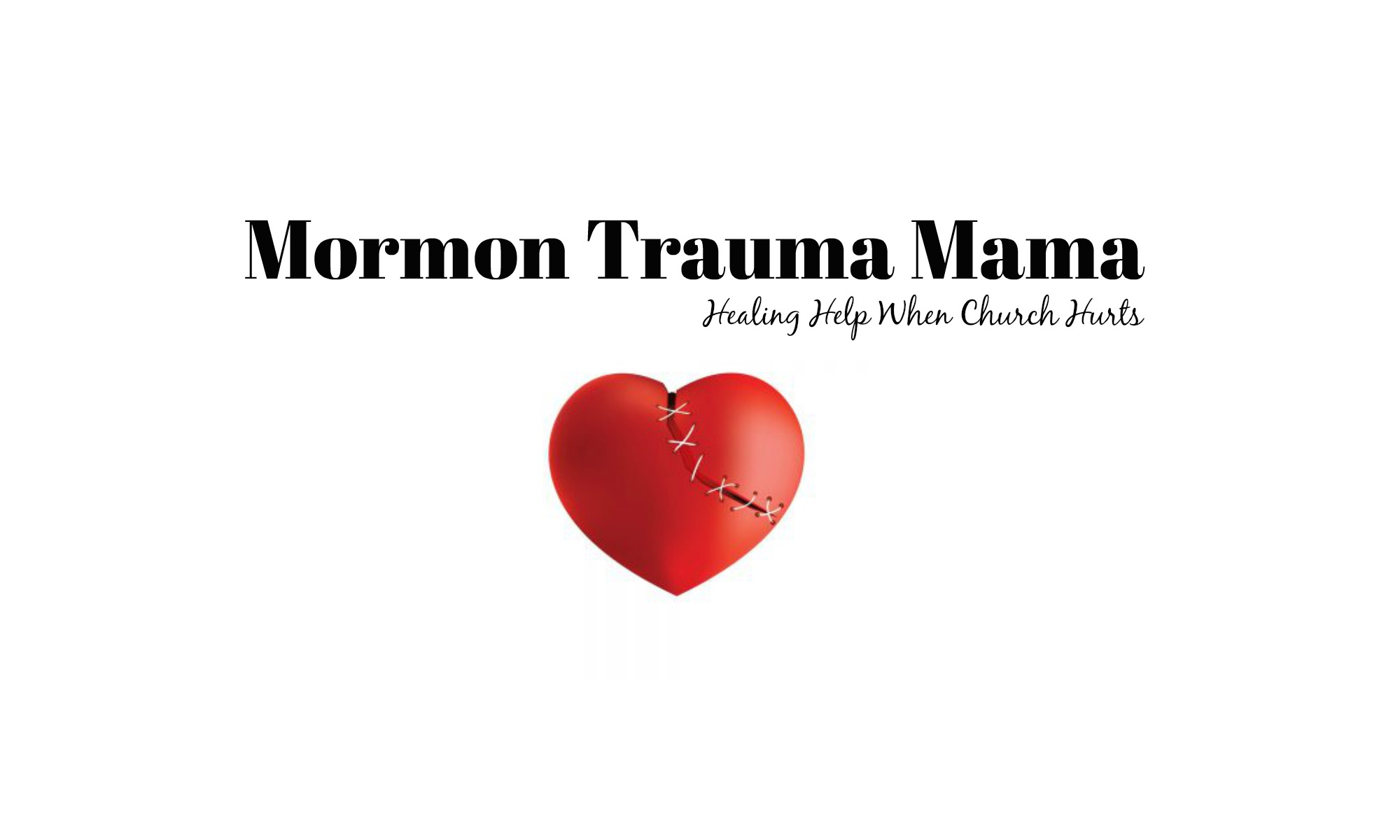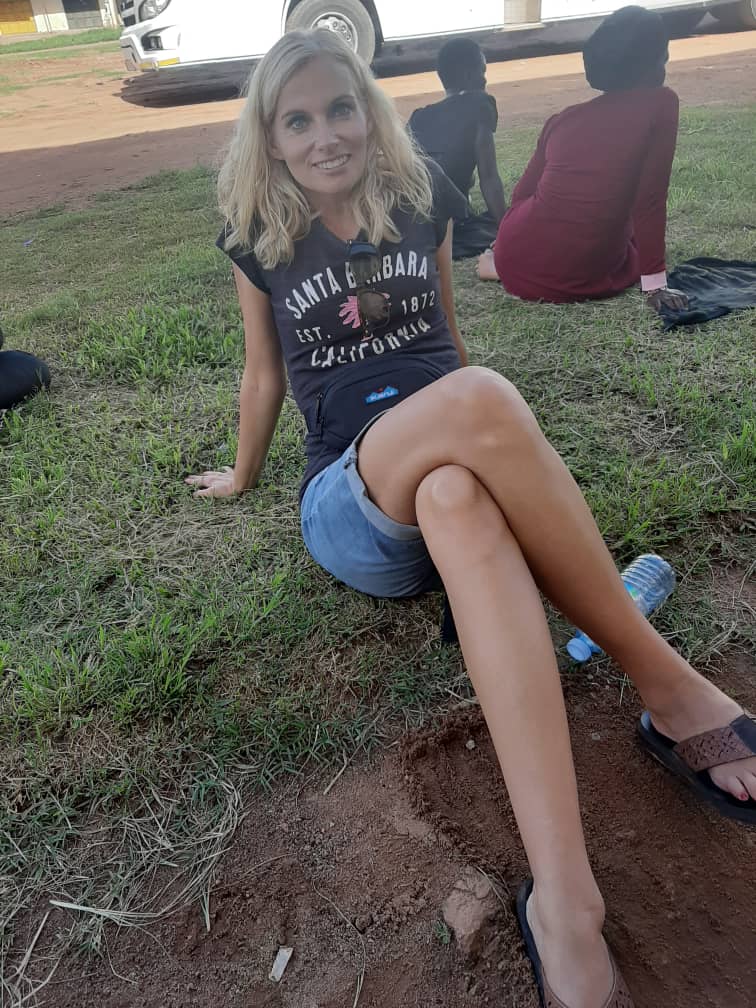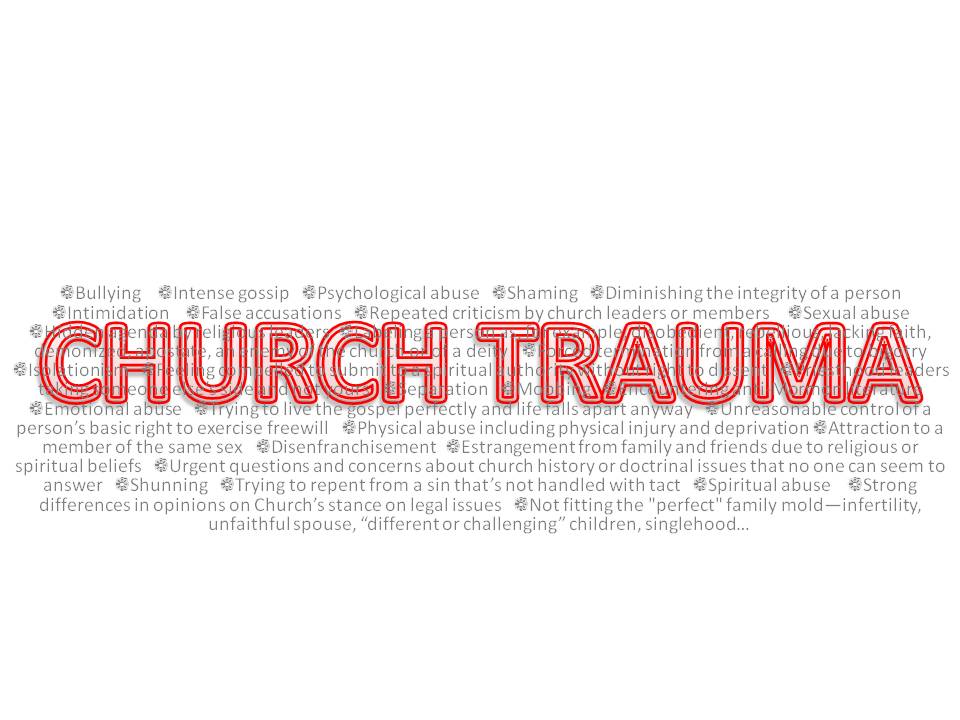
Chapter 1: Understanding and Managing Church Trauma—Finding Help and Healing for Mormons
Following is my master’s thesis on church trauma. I will post it in sections. This article will include all of my thesis’s chapter one but because chapter two is so long and comprehensive, it will be published in smaller parts (the whole thesis is 112 pages). For easier reading and clarity, I will label each section a new chapter. Because it is a thesis, it is quite formal in nature, which I hope will be appreciated. I will plan on posting a new section weekly. May you enjoy and find value in this series.
Chapter One
Introduction
Church trauma is a largely uncharted area of investigation that is just beginning to grasp the attention of researchers (Schiffman, 2019). Because church trauma is so new to the table, researchers are still trying to settle on a name for it. It has been called spiritual abuse, religious abuse syndrome, spiritual trauma, post-traumatic church syndrome, abuse of religious authority, church hurt, religious trauma, and many other terms. For clarity in this thesis, it will simply be called “church trauma.” Although church trauma is prevalent in all religions, the main focus here will be for those who have suffered from trauma within the Mormon faith.
Church trauma has a very damaging effect on those who suffer, mirroring the symptoms of post-traumatic stress disorder (PTSD) (Corey, 2013). A discussion of the causes and effects of church trauma within the Mormon Church will be outlined in this thesis. Following the discussion of what church trauma is and how it affects members, focus will then be turned to how to heal from the shattering effects of religious abuse. This is important because once we identify trauma, it is important that we do not become too addicted to it as we move towards posttraumatic growth.
Background of the Problem
Trauma is the feeding system for every social ill in our society. If we want to reduce social problems, we have to get down to the root of the problems, which are trauma-based (Whitfield, 2016). Trauma-based problems include bullying, domestic violence, crime, child abuse, mental illness, etc. It even includes physical ailments such as heart disease and cancer. Whatever it is that society cares about, trauma must be examined and addressed because the systematic problems are connected to trauma (Harris, 2015).
Thus it is with church trauma. In our culture, it is generally assumed that religion is benign and good for you (Tarico, 2015), but studies show that church can be a means of great harm. For example, 64% of families who experience church trauma feel forced to relocate; 66% of children are forced to change schools; 67% of family members of church trauma victims report experiencing detrimental effects on family well-being and physical health (Speight & Speight, 2017); and 10-20% of those who have been mobbed or bullied at church commit suicide (Tanner, Wherry, & Zvonkovic, 2013).
Mobbing alone is a serious form of church trauma, which is hostile and unethical communication which is directed in a systemic way by one or a few individuals. The individual is pushed into a defenseless position and held there by means of continued mobbing activities. Mobbing activities that people experience may include: 1) victims are silenced by those in charge and left with the inability to speak out of fear, 2) verbal threats, and other verbal activities which become part of keeping people from doing their callings or work effectively, 3) ridicule, 4) gossiping or rumors, 5) being given patronizing or meaningless tasks, and 6) being harassed in threatening ways (Tanner et al, 2013).
Thus, because of the severity of grievances that church trauma presents, if these systemic issues keep coming forth, trauma is the starting place that must be examined and rooted out if we ever hope to have healthier congregations. If there is more knowledge to gain and better approaches for religions to take, trauma is where we must begin our investigation in order for healing to become a reality.
Statement of the Problem
Church trauma ought to be of great concern to Mormon leaders because of the effect it has on individuals who suffer from church trauma and how that affects activity and worship. It is estimated that within the Mormon Church, two-thirds of its members are inactive (Dehin, 2017). Leaders need to be asking why. The pain, struggle, and damage are real, potentially affecting all involved—not just the individuals but families, marriages, and congregations. Further, research shows that church trauma affects individuals psychologically, socially, and physically (Abu-Raiya, Paragment, & Krause, 2015). This is especially true as one considers the research on religious coping. When one finds that their spiritual support network has been uprooted, there are detrimental and unique psychological consequences. This is important to understand as religious support has been shown to contribute to posttraumatic growth while religious strain is positively linked to posttraumatic symptoms (Bassett, Carrier, Charleson, Pak, Schwingel, Majors, Pitre, Stroller, & Bloser, 2016). Indeed, religious/spiritual struggles have been linked to greater anxiety, depression, suicidal ideation, poorer physical health, and even higher mortality rates (Abu-Raiya et al, 2015).
Because the concept of church trauma is so new to the table, it has been an uphill battle for researchers particularly because most churches, including the Mormon Church, do not want to admit that church can be a place that hurts more than it helps (Speight & Speight, 2017). Thus, many churches are unwilling to work with researchers. However, thankfully, headway is starting to be made. Many aspects and conflicts are beginning to be considered. Hopefully, leaders in the Mormon Church will also begin to work with researchers as well as trauma victims so that healing can be expedited and membership can be positively impacted.
Purpose
The purpose of this study is to shed greater light on what is causing trauma in the Mormon Church, what the consequences of those traumas are, and how trauma victims can be helped through the painful process of finding posttraumatic growth. Successful navigation through trauma will be examined. It is hoped that this thesis will promote healing as well as increase sensitivity and awareness for what is really happening to many members—active and inactive—in the Mormon Church.
Theoretical Framework
Church trauma is destroying the worth, the faith, the trust, and the ambition of so many members of the Mormon Church. Rather than embracing and hearing the hurting members, too often victims are hushed or dismissed. In addition to the horrendous traumas themselves, responses to their traumas are causing a great deal of long-lasting harm to not only the traumatized but to the religious organization as a whole. If the causes and effects of church trauma are better understood and acknowledged, members and post members can begin to find help and healing. If embraced, it will benefit Mormon communities as a whole.
To meet this challenge of obtaining a data-rich description of the phenomenon under study, grounded theory-data analysis will be utilized in order to construct theories that are rich in detail and firmly “grounded” in the data (Corbin & Strauss, 1990). The literature will be organized thematically, according to the root causes of trauma in the Mormon Church. The focus will then turn to the consequences of trauma and finally on posttraumatic growth.
Research Question
The question that will be investigated after an analysis of the causes and effects of church trauma is “how can the traumatized within the Mormon Church find help and healing post trauma?”
Hypothesis
It is proposed that if church trauma victims and those surrounding them seek to accept and understand what has happened—embrace the reality of church trauma within the Mormon Church, rather than resist it—all that are affected by it (i.e. individuals, families, congregations) would be positively impacted and would begin to heal.
Importance of the Study
There are so many hurting within the Mormon Church, and at point, it is largely unacknowledged and unaccepted. Many do not know where to turn or how to move forward. Part of this is because they do not understand what has happened and what is happening post trauma. Victims often feel completely sideswiped after church trauma because the only level of hurt they have been taught in the Mormon faith is offense (Bednar, 2006). Teaching about offense and how to forgive are helpful but it only goes so far as it places the responsibility and blame on the victims of abuse. This study is an attempt to bring understanding, hope, and healing to not just the traumatized but to church leaders as well as all members within the religion.
Scope of the Study
This thesis does not give an exhaustive explanation of each type of trauma to be found within the Mormon Church. It merely provides an overview of some of the more common sources. Likewise, the effects of trauma are not comprehensive as each person responds to trauma differently. It does, however, give an overview of some of the more common causes and effects of trauma found in the Mormon Church.
Healing is individual. So what helps one move into posttraumatic growth may not be the solution for another. However, many ideas of how one can heal will be presented in hopes that they can serve as a springboard to other ideas that may help leaders, sufferers, and church members find greater peace as well as personal and communal growth and purpose.
Definition of terms
Church trauma
Church trauma has been defined as a condition of serious spiritual injury that occurs as a result of religion or faith. It is the vile, noxious, and icky aftermath of intense spiritual injury (Corey, 2013). It has also been defined as an individual’s suffering from psychological distress as a result of religious trauma (Bilsky, 2013). It is a set of symptoms and characteristics that tend to go together and which are related to harmful experiences with religion. They can be the result of at least two things: (1) immersion in a controlling religion, and (2) the secondary impact of leaving a religious group (Tarico, 2015).
Organizational Behavior
Organizational behavior is the role that systems, structures, and processes have in shaping behavior. A study of organizational behavior helps one understand how an organization really works (www.css.edu). It is often viewed as the corporation side of religion. The bottom line of organizational behavior is to explain and predict behavior within an organization.
Cultural Behavior
Culture is defined as sets of shared and socially transmitted ideas and means used by groups to interpret and guide lives. Culture is a multidimensional concept that encompasses the “collective reality” from which all attitudes, behaviors, and values are formed and reinforced by people (Zaker & Boostanipoor, 2016). It is culture that then leads to cultural behavior, rituals, expectations, and worldview of its members. It affects the way group members think and act as they are urged to conform or to discourage dissent.
Benevolent Patriarchy
Benevolent patriarchy is male control over political, economic, legal, marital spheres. It is rooted in gender differences assumptions. Women are subjected to motherhood as an ideal. Women are viewed as in need of protection and leadership (R-M, 2014).
Unrighteous Dominion
Unrighteous dominion is abuse of power and authority. Unrighteous dominion is essentially spiritual abuse but this term is used because it is found in the Mormon’s canonized scriptures—Doctrine & Covenants 121:39. Unrighteous dominion is a form of psychological manipulation used by abusers to coerce victims into compliance by using religious beliefs as leverage. Doctrine is used by both the abuser and the enabling members of the congregation to force victims into subjection (Thomson, 2017).
Summary and Organization of Remaining Chapters
Much understanding and work is needed in the area of church trauma. This thesis seeks to draw curiosity and attention of trauma within Mormonism. It will be organized as follows:
Chapter Two will begin with an illustration of how church trauma often looks in the Mormon Church. Using related literature on the subject, each root cause will be examined followed by the consequences. Following that discussion, the chapter will explore the literature on navigating successfully through trauma as it applies to religion.
Chapter Three will further inspect the research findings on healing. How the traumatized can find help and healing will be considered, analyzed, and summarized. Conclusions from the research will be drawn along with suggestions for further research.






7 Comments
Darrell Marshall
Good one Danna. While I have not left the church for its lied and broken promises and inability to reach those in charge, protected by the Corporate.Church, I have been subect to unrighteous dominion by thr SP despite compassiin of my Bishops. The Church now blames me following a 2008 relpase of a 1974 LTM caused permanent incurable health condition, that it accepted responsibility for in 1980 after paying for my first brain surgery. Anyway keep up your good work. O no longer hear from McKenna Denson who referred me to you. Do you hear from her at all. Thanks for listening
Danna Hartline
Hi Darrell, nice to hear from you. No, I have lost touch with McKenna.
Tim Shropshire
This will help many people!!! I look forward to reading this series! Your work is always quality!!
Bill H.
Knowing you, this is going to be amazing!! Looking forward to it!! Thank you for all your hard work!
Bailey Farmer
I know you left this work for awhile but it’s good to see you back. This part of the world still needs to hear your voice. Your expertise in this area is needed.
Nath
Félicitations ! Continuez aussi !
Jane Walker
I can tell this is going to be a quality thesis. I look forward to studying the rest.